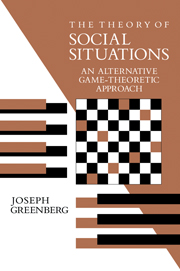Book contents
- Frontmatter
- Contents
- Preface
- 1 Overview
- 2 The theory of social situations
- 3 Examples
- 4 Abstract stable sets
- 5 Existence and uniqueness of OSSB and CSSB
- 6 Characteristic function form games
- 7 Normal form games
- 8 Extensive form games with perfect information
- 9 Infinitely repeated games
- 10 Implementation by means of situations
- 11 Closing remarks
- References
- Index
8 - Extensive form games with perfect information
Published online by Cambridge University Press: 05 June 2012
- Frontmatter
- Contents
- Preface
- 1 Overview
- 2 The theory of social situations
- 3 Examples
- 4 Abstract stable sets
- 5 Existence and uniqueness of OSSB and CSSB
- 6 Characteristic function form games
- 7 Normal form games
- 8 Extensive form games with perfect information
- 9 Infinitely repeated games
- 10 Implementation by means of situations
- 11 Closing remarks
- References
- Index
Summary
Of the three game forms, it is the extensive form, or the game tree, that provides the most detailed description of the actions that are available to the players. I shall argue that, as was the case with the other two game forms, this description is not adequate. On the one hand, it fails to specify, for example, the legal institutions, such as whether it is possible for a player to selfcommit to his future actions. [It is the answer to this question that lies at the heart of the distinction between Nash and subgame perfect equilibria (see Definitions 8.0.3 and 8.0.4).] And, on the other hand, it involves unnecessarily detailed information:
The game tree is an extremely useful device for didactic purposes, but one must often pay a high price for its use, in terms of redundancy. The rules of many games permit the same physical “position” to be reached through various different sequences of moves. Yet in a tree each sequence of moves must lead to a different node. The tree convention forces us to remember the history of the position, whether we want to or not
(Shubik 1984, p. 48).Insisting on such a detailed description is not only “wasteful”; it also has serious consequences.
- Type
- Chapter
- Information
- The Theory of Social SituationsAn Alternative Game-Theoretic Approach, pp. 118 - 145Publisher: Cambridge University PressPrint publication year: 1990



